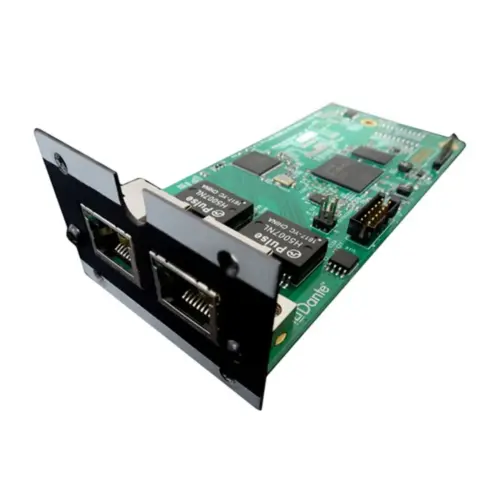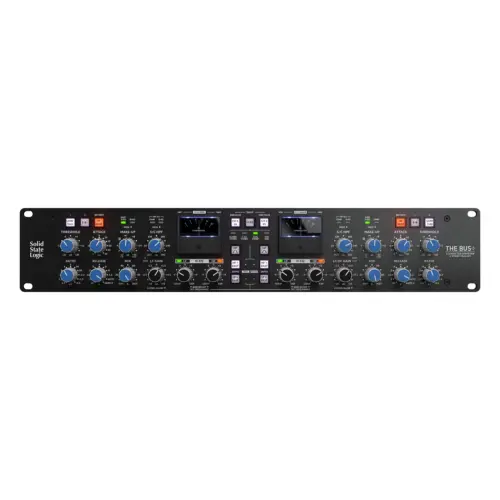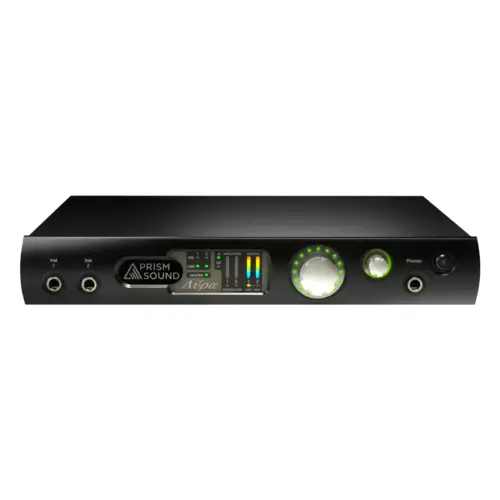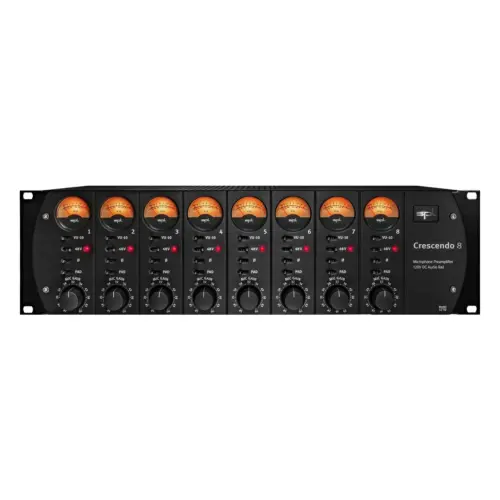The Rupert Neve Shelford Channel is built around Rupert Neve’s first new transformer-gain, class-A microphone preamplifier in over 40 years, a “best-of-the-classics” inductor EQ section, a tone-packed diode bridge compressor, the power of variable Silk saturation, a new custom transformer output stage, and twice the operating voltage of vintage designs.
Over fifty years in the making, the Rupert Neve Shelford Channel is the definitive evolution of the original technologies in Rupert’s classic console modules like the 1073, 1064 & 2254, thoughtfully advanced and refined for the 21st century studio.
The Input Stage and Transformer Gain Mic Pre
Like Rupert’s designs from his time in Little Shelford , the Shelford Channel’s preamplifier uses a directly-coupled transformer input with gain provided by the custom transformer itself – a first in over 40 years for Rupert Neve.
This new custom-designed input transformer, along with its careful integration with the surrounding class-A circuitry, is critical to the Channel’s bold and instantly recognizable character.
Conveniently, the Direct Input uses the same topology as the best-selling RNDI Active Transformer Direct Interface, providing astonishing clarity for high-Z instrument signals, with unparalleled low-frequency response and an incredibly smooth high end.
What is Silk?
The Silk & Texture circuit on the Rupert Neve Shelford Channel allows you to fine-tune the amount (and type) of harmonic content in the output stage. This means your signal can be adjusted from quite transparent to settings that produce nearly 10x the amount of sonic color as Rupert’s vintage modules – and in two very unique modes. No matter what sound you’re looking for, Silk can help get you there.
The Custom Transformer Output
The Rupert Neve Shelford Channel has a custom transformer output stage with a balanced standard LINE level output. Additionally, a separate -6dBu XLR output can compensate for high levels of input and Silk harmonic saturation, enabling engineers to fully drive the Shelford to achieve more transformer harmonics without clipping the next device in the chain. Both outputs are active and can be used concurrently.
The LINE output is designed capture a more pristine sound at high levels, avoiding non-linear coloration of the output stage and taking full advantage of the Shelford’s higher voltage design. The -6dB out however is optimized to allow an engineer to drive the full voltage range of the Channel – adding dynamic tone with these same non-linear “colorations” – without clipping most professional interfaces.
On drums, vocals, guitars and other instruments, this output lets you easily hit the transformer’s “sweet-spot” of non-linear harmonic content, which can bring a recorded performance to life in a way that other effects can’t.
The “Best-Of” EQ
The Rupert Neve Shelford Channel’s 3-band, custom-tapped inductor EQ was inspired by our favorite elements of Rupert’s vintage EQ designs. The low frequency band is designed to produce a creamy, resonant bass response similar to a vintage 1064 – but unlike the vintage modules, the LF band on the Shelford Channel can be used as either a shelf or a peak filter, adding punch, dimension, and control to your low end.
The midrange band is based on that of the 1073, ideal for sweetening vocals and instruments while bringing them forward in a mix, and its proportional “Q” response makes it well-suited for minimizing problematic frequencies.
The high frequency band is a hybrid vintage / modern design, blending inductor circuitry with capacitor-based topologies to achieve vintage tones with enhanced control, with the shelf / peak corner switchable between 8K or 16K.
The Diode Bridge Compressor
Like the Inductor EQ and Transformer Gain microphone preamp, the Diode Bridge Compressor in the Rupert Neve Shelford Channel is based on the same topologies found in Rupert’s vintage designs – but refined & adapted for the modern engineer.
What is diode bridge compression? Where the VCA compressor found in the Master Buss Processor provides unmatched clarity, the weighty, harmonically rich tonality of diode bridge compression can be essential in pushing key sources like vocals, electric guitars, bass and drums to the forefront of a mix.
By understanding the limitations of vintage units like the legendary 2254, painstaking effort was taken to reproduce the unique tone of these classics while improving the noise floor & accuracy, expanding inflexible time constants, adding full wave sidechain detection for improved dynamic response, and widening the range of threshold and ratio controls.
Delivering the powerful sound of these iconic designs with enhanced flexibility for the modern age, the Shelford’s diode bridge compressor is a dynamic tool equipped to make a statement on virtually any mix or track.
With an infinite variety of tone, the Rupert Neve Shelford Channel maintains the soul of Rupert’s vintage designs with new levels of versatility, delivering the combined essence of fifty years of Rupert Neve’s designs.
MIC PREAMP
INPUT IMPEDANCE 2200 Ohm
MAXIMUM INPUT LEVEL
+21.5 dBu from 150Hz to 22kHz, +8 dBu 20Hz to 22kHz
NOISE
Un-weighted, 22Hz – 22kHz, source impedance 150 Ohm balanced.
Line Out (Unity Gain) -100.9 dBu, -6dB Out (Unity Gain -106.6 dBu
Line Out (+30dB Gain) -91.37 dBu, Line Out (+66dB Gain) -64.1 dBu
Equivalent Input Noise -121.37 dBu
FREQUENCY RESPONSE 17Hz to 45kHz: +/-0.25 dB
DIRECT INPUT
MAXIMUM INPUT LEVEL +8 dBu from 20 Hz to 120 kHz
NOISE (LINE OUT) -100 dBu (22Hz to 22kHz)
LINE INPUT
MAXIMUM INPUT LEVEL +30.5 dBu from 20Hz to 30kHz
TOTAL HARMONIC DISTORTION AND NOISE
@ 1 kHz, +20 dBu output level, no load: Better than 0.002%
@ 20 Hz, +20 dBu output level, no load: 0.05% Typical (2nd and 3rd harmonic)
NOISE (MAIN OUTPUT)
Un-weighted, 22Hz – 22kHz, source impedance 40 Ohm balanced, no load. -101.1 dBu
FREQUENCY RESPONSE
<10 Hz to 110 kHz: +/- 0.25 dB, 120 kHz: +/- 0.32 dB
MAXIMUM OUTPUT LEVEL 16Hz to 20kHz: +26 dBu
HIGH PASS FILTER
Continuously variable swept frequency from 20 Hz to 250 Hz. Slope: 12 dB/Octave
EQ NOISE Un-weighted, 22 Hz-22 kHz: -92 dBu
SIGNAL PRESENT
Illuminates GREEN when input stage signal level reaches -20 dBu
OVERLOAD INDICATOR
Illuminates RED when input stage signal level reaches -23 dBu
DIODE BRIDGE COMPRESSOR SECTION
COMPRESSOR NOISE (BW 22 Hz – 22 kHz)
0dB Makeup Gain: -84.5 dBu
+20dB Makeup Gain: -64.2 dBu
Download the User Manual in PDF format.
$6,800 Original price was: $6,800.$6,749Current price is: $6,749. Inc GST
Seen a better price?
We will beat any advertised price on in stock items.




‘Ordio Productions’ and the Ordio Productions Logo are owned exclusively by Ordio Productions
If you have any questions, please contact us
All content is the copyright of Ordio Productions and cannot be used without written permission